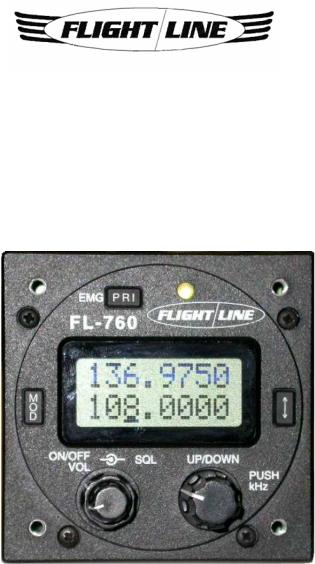Fightline FL-760 User Manual

FL-760
VHF Aircraft Transceiver
Installation / Operations Manual
FL-760 series
Flightline
12830 E. Mirabeau Parkway Spokane Valley, WA 99216 Toll free tel.: 1-800-235-3300 Toll free fax: 1-800-828-0623 http:// www.edmo.com
VHF AM Aircraft Radio
FCC ID: VOSFL760 A
Page 0

ATTENTION
READ ME FIRST
FCC WARNING
Changes or modifications not expressly approved by the party responsible for compliance could void the user’s authority to operate the equipment.
NOTICE
This equipment has been tested and found to comply with the limits for a Class A digital device, pursuant to part 15 of the FCC Rules. These limits are designed to provide reasonable protection against harmful interference when the equipment is operated in a commercial environment.
This equipment generates, uses and can radiate radio frequency energy and, if not installed and used in accordance with the instructions, may cause harmful interference to radio communications. Operation of this equipment in a residential area is likely to cause harmful interference in which case the user will be required to correct the interference at his own expense.
Properly shielded a grounded cables and connectors must be used for connection to host computer and / or peripherals in order to meet FCC emission limits.
AC adaptor with ferrite core must be used for RF interference suppression.
The Flightline transceiver has been factory preset and in most cases the transmitted audio should be correct. A 15 pin connector is supplied for connection to the electrical system and microphone/speaker.
Notes to the installer / user.
This is a 14-volt or 28-volt DC radio, voltages greater than 33 volts DC or AC voltage will severely damage it.
When making adjustments to the transmitter, ensure that you are not on an occupied channel.
Do not transmit on 121.500MHz, as this is the international distress frequency.
Do not transmit into an unterminated antenna line as a suitable antenna must be connected. Transmitting without being connected to an antenna may damage the radio.
Ensure that the supply voltage is regulated and does not fall below 11.7 volts DC or exceed 31 volts DC.
The transceiver is not waterproof. Do not allow it to get wet.
Speaker impedance must be either 4 or 8 ohms (4 ohms preferred) at 5 watts.
Use of electret microphones highly recommended.
About this document.
Due to our policy of continuous improvement to our products and services, technical specifications and claims are correct at time of going to printing, however they are subject to change without notice.
Flightline does not accept liability for any error or omission.
This manual remains the copyright of Flightline.
Page 1
TABLE OF CONTENTS
SECTION |
Page |
ATTENTIONREAD ME FIRST ………………………………………………….1
TABLE OF CONTENTS……………………………………………………………2 1 INTRODUCTION ……………………………………………………………….. 3 2 INSTALLATION INSTRUCTIONS ……………………………………………. 3 3 INSTALLATION CONSIDERATIONS ………………………………………….3
4 GENERAL ………………………………………………………………………….4
4.1Sailplanes ………………………………………………………………………………………4
4.2Ultralights …. ………………………………………………………………………………… 4
4.3Microlight / Homebuilt / G.A. ……………………………………………………..4
5 BEFORE BEGINNING INSTALLATION………………………………………..….……5
5.1Installation parts identification..………………………..…………………………....5
5.2Transceiver installation and removal ……..………………………………………... 5
5.3General..……………………………………………………………………………..……5
5.4Pin connections ...…………………………………………………………….…………. 5
5.5Mechanical installation ...…………………………………………………………….…5
5.6Electrical installation ……………………………………………………………………6
5.7Antenna installation.. ………..........................................................................................7
5.8Tuning ……………………………………………………………………………………………….7
5.9On air testing ………………………………………………………………………………………7
6 OPERATION OF EQUIPMENT ……………………………………………………………8
6.1General ………………………………………………………………………………….....8
6.2Control description …………………………………………………………………..…8
6.3Memory programming …………………………………………………………………10
6.4Memory delete …………………………………………………………………………. 10
6.5Operation of intercom ……………………………………………………………. 10
6.6User setting …………………………………………………………………………. 10
6.7Music input …………………………………………………………………………….. 11
7 SPECIFICATIONS ………………………………………………………………………… 12
8 HELPFUL HINTS …………………………………………………………………………. 13 WARRANTY
EXTERNAL CONNECTIONS
Page 2
1 INTRODUCTION
Thank you for purchasing this quality product from Flightline.
This transceiver has been designed and manufactured in Japan specifically for Ultralights, Gliders and General Aviation Aircraft and Helicopters with size and power consumption as the main considerations. Ease of operation was another primary achievement.
Please follow this manual closely to ensure optimum performance, we do hope you have many hours of trouble free communication and safe flying.
2 INSTALLATION INSTRUCTIONS
This manual contains all of the necessary instructions for installation and operation. After installation please keep this manual in a safe place for future reference.
3 INSTALLATION CONSIDERATIONS
As with all aircraft radios, successful communications start with the installation. After unpacking the transceiver verify all parts against the parts list. Select a suitable mounting area within a maximum 30 degree viewing angle and select a suitable location for operation of ancillary controls, backlight, intercom etc.
The use of aviation quality shielded cable is recommended at all times.
Avoid running or wrapping other wires around the antenna lead and keep lengths as short as reasonably possible. Ensure that the radio is not exposed to direct rain or moisture (we do not accept liability for water damage).
Make sure the transceiver is connected to a 11.7-16.8 volt or 23-33 volt battery system. Do not use AC volts from a Rotax lighting coil.
Page 3
4 GENERAL
The following section is a guide for individual types of aircraft installations.
4.1 Sailplanes
Due to the inherent space restriction on most glider instrument panels the FL-760’s 57-mm front panel makes it an excellent choice for confined spaces. Generally the radio is mounted at the bottom of the panel with essential instruments at the top. Location of the ancillary switches should be convenient to the pilot.
The Press to Talk (PTT) can be a normally open push-button located on the control column or a handheld microphone.
Speakers are normally located at the rear of the pilot’s head.
If not using a handheld microphone, then a boom mike with an electret microphone is preferred.
If this radio is to be installed in a motor glider then ensure that the ignition leads are shielded. This will reduce ignition noise considerably. The FL-760 has noise limiting circuitry incorporated and works well in most cases but two stroke interference can be difficult to suppress.
4.2 Ultralight
Most ultralights like sailplanes suffer from space restriction. Locate the transceiver with a good viewing angle. Ensure that it is protected from rain (No liability is accepted for water damage).
Use shielded aviation quality wire for the headphones, microphone, and speaker.
As nearly all Ultralights use two-stroke engines ignition noise can be a problem. Again ensure that all engine high voltage cabling is shielded and grounded. There is almost certainly some background ignition noise with these engines, however, the FL-760 noise limiter will eliminate nearly all of the noise (except for levels around 5 uV).
In tandem or side by side seating, use of the intercom provided will work well providing you switch it on. The intercom uses the side-tone feature of the radio and therefore may pick-up some ambient noise.
Another feature is the fitting of the external memory toggle switch which when fitted (normally on the control column) allows the pilot to scroll through the memory channels and select scan without reaching for the main channel controls on the radio. This is particularly useful for the rear pilot or instructor in tandem Ultralights or for Helicopter/Gyroplane pilots.
4.3 Microlight / Home built / G.A.
In general the same as for ultralights with particular care taken for ignition screening and exposure to rain.
Page 4
